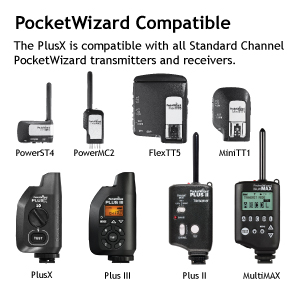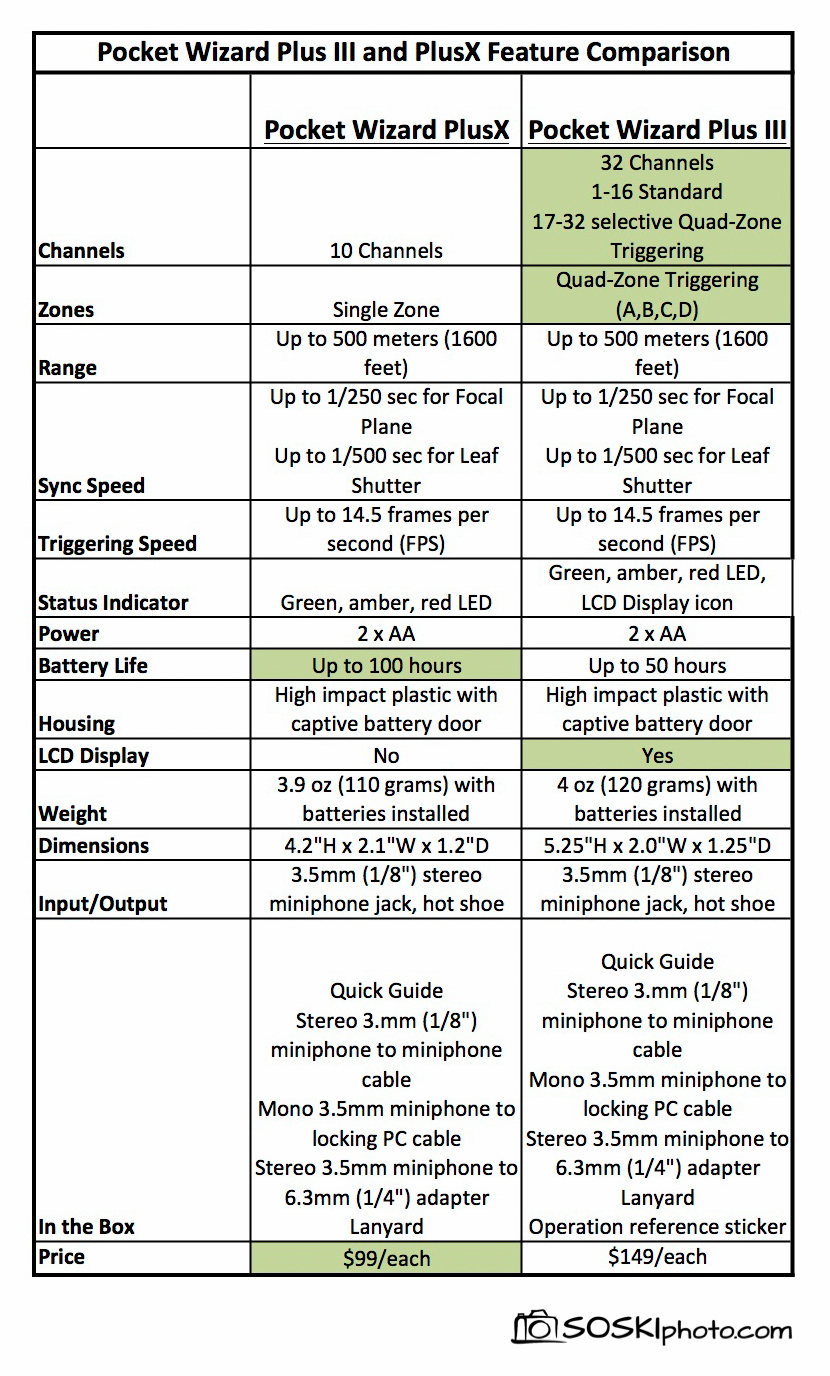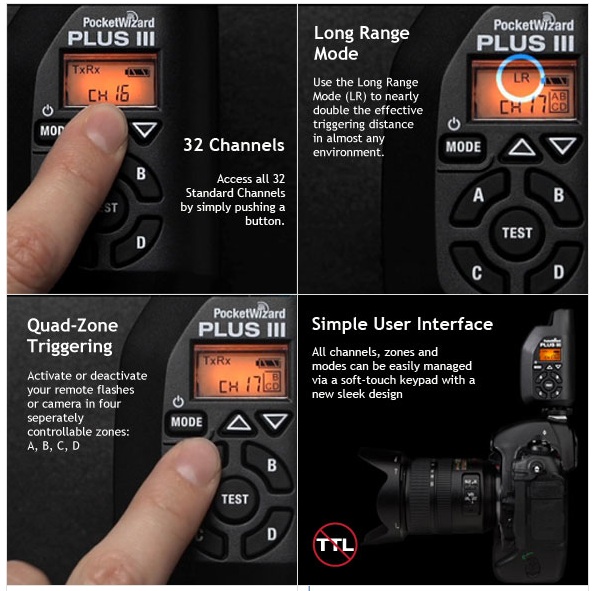Pocket Wizard, the industry leader in radio transceivers for studio flashes and speedlites, recently announced their budget friendly PlusX. With the PlusX's top notch build quality, updated feature set, and friendly price, there is no denying that this radio trigger will take the Strobist market by storm.
Last year, Pocket Wizard released the high-end Plus III, which offers all of the bells and whistles any photographer could ask for. Although the Plus III sells for less than the classic Plus II did, photographers still complain that the price is too high.
Now for the million dollar question, does the new PlusX offer enough bang-for-the-buck or is the Plus III a better buy? Find out after the break.
Pocket Wizard PlusX and Plus III feature comparison:
Before we can decide which transceiver is the better buy, let's take a look at their features side-by-side:
Pocket Wizard PlusX and Plus III feature comparison.
As you can see from the table above, the PlusX and Plus III offer the same compact and high-end plastic housing, internal antenna, massive radio triggering range, and triggering performance. Both transceivers take AA batteries and offer a LED battery life indicator. The real difference between the two units is that the Plus III offers 22 more channels, Quad-Zone triggering, and an LCD display.
Target Users:
The Plus III is targeted for the professional photographer who:
1. Works with an abundance of flashes and wants to control them independently in zones,
2. Uses remote flashes and cameras in large venues (Olympics, basketball, baseball, etc.),
3. Covers an event where dozens of photographers will be filling the standard 10 radio channels (formerly only 4 channels).
In any of these scenarios, the photographer can benefit from the Plus III's 32 channels (#2/#3), Quad-Zone triggering (#1/#2), and Long Range Mode (#2).
The Pocket Wizard Plus III unique feature set.
The PlusX on the other hand is targeted for users who work individually or in small groups and those who have a lower budget for reliable radio triggering. There is no denying that the simple user interface will create a smooth and quick work flow when working alone, with subjects' family and friends, and inexperienced college interns. Watch the video below to see the PlusX in action.
Final Thoughts:
The Pocket Wizard PlusX is a great buy and offers plenty of bang-for-your-buck, especially when considering the original industry standard Plus II that was nearly twice as expensive, offered only 4 channels, and had no battery life indicator.
The choice between the PlusX and Plus III is simple. If you need the transceiver for basic flash triggering and remote camera use, save a few bucks and buy the PlusX. If you work with dozens of lights, in huge venues, or alongside an abundance of photographers crowding the radio channels, then spring for the Plus III.
Whatever you decide, keep in mind that you need one transceiver for you camera's hotshoe and one for each flash. In a basic two flash setup, you need three transceivers. That would run you $297 for a PlusX setup or $447 for a Plus III setup.
What are your thoughts on the Pocket Wizard PlusX and Plus III? Is the PlusX overpriced? Is there a better alternative on the market? Share your thoughts in the comments below!




Thank you for your hopeful post. I am very glad to read that an i thing i will be very grateful by flowing it. I will to be a unique visitor of your blog. Can I help from you. I have a site that is similar to you. If you permit me then I want to use your article in my blog.
ReplyDeleteOh, now this is exciting! What a lucky find for me. I look forward to participatingWizard101!
ReplyDeleteWould it make sense to get 2x Plus X, and 1x Plus iii. if using 1 canon 70d with 1x 600EX-RT and another slave speedlite? - (a budget decision)
ReplyDeleteor 2x Plus iii and a single Plus X(purely for its simplicity?
Will I still be able to access full flash settings in-camera.
I may use 2 other optical slaves in addition.
I gues I will also lose use of the hash pop-up flash.
any opinion welcome
sorry 1 more thing.
ReplyDeletedoes any of these triggers have power save AUTO-OFF?
Very awesome...........
ReplyDeleteI have also like you........
Photobooths world
these are nice!
ReplyDeleteThis comment has been removed by the author.
ReplyDelete360 product product photography requires extra consideration when it comes to picking a tripod and a tripod head. Here we would like to share few helpful tips on how to pick the right equipment.
ReplyDeleteWedding photographers time after time have been told from grooms and brides "the wedding day flies past in an instant" and all that there is following your wedding day are your wedding photographer So it absolutely is a good idea to spend a bit of time exploring the best Raleigh photographer for your Raleigh wedding.
ReplyDeleteThe University of Louisville Library was one site that had a never-fading impression on me not only for its unique architectural plan but for other inexpressible qualities that make it an ideal place for quiet and serene study. My first visit was for an induction into the use of the internet in literature research. The class was fully equipped with computers in all the over fifty desks and a master screen monitor for the instructor. I passed through the library on many other occasions. 14 Architectural Photos That Will Make You Look At Buildings Differently
ReplyDeleteIf you are interested in photography and you don't have enough time to study in photography school or institute, online photography courses are presumably one of the best ways to improve your photography skills. There are hundreds of photography courses online that will offer you all types of results. photography workshop kolkata
ReplyDeleteAs usual, your content is always awesome and you bring the latest update available. Your blogs are always satisfying.
ReplyDeleteMahindra Blazo X 42